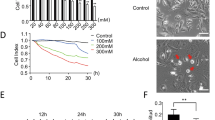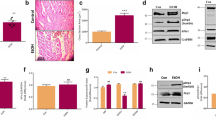Abstract
Alcohol abuse is a risk factor for a distinct form of congestive heart failure, known as alcoholic cardiomyopathy (ACM). Here, we investigate how microRNAs may participate in the induction of cardiomyocyte apoptosis associated with ethanol exposure in vitro. Increasing the concentrations of ethanol to primary rat cardiomyocytes resulted in elevated apoptosis assessed by annexin V and propidium iodide staining, and reduced expression of an enzyme for alcohol detoxification aldehyde dehydrogenase 2 (ALDH2). These ethanol effects were accompanied by a substantial elevation of miR-378a-5p. Driving miR-378a-5p overexpression in cardiomyocytes decreased ALDH2. The specific interaction of miR-378a-5p with the 3’UTR of ALDH2 was examined by luciferase reporter assays, and we found that miR-378a-5p activity depends on a complementary base pairing at the 3′-UTR region of ALDH2 mRNA. Finally, ethanol-induced apoptosis in cardiomyocytes was attenuated in the presence of anti-miR378a-5p. Collectively, these data implicate a likely involvement of miR-378a-5p in the stimulation of cardiomyocyte apoptosis through ALDH2 gene suppression, which might play a potential role in the pathogenesis of ACM.





Similar content being viewed by others
References
Bala S, Marcos M, Kodys K, Csak T, Catalano D, Mandrekar P, Szabo G (2011) Up-regulation of microRNA-155 in macrophages contributes to increased tumor necrosis factor α (TNFα) production via increased mRNA half-life in alcoholic liver disease. J Biol Chem 286:1436–1444. doi:10.1074/jbc.M110.145870
Bala S et al (2012) Circulating microRNAs in exosomes indicate hepatocyte injury and inflammation in alcoholic, drug-induced, and inflammatory liver diseases. Hepatology 56:1946–1957. doi:10.1002/hep.25873
Balbo S, Brooks PJ (2015) Implications of acetaldehyde-derived DNA adducts for understanding alcohol-related carcinogenesis. Adv Exp Med Biol 815:71–88. doi:10.1007/978-3-319-09614-8_5
Brooks PJ, Theruvathu JA (2005) DNA adducts from acetaldehyde: implications for alcohol-related carcinogenesis. Alcohol 35:187–193
Camera DM, Ong JN, Coffey VG, Hawley JA (2016) Selective modulation of microRNA expression with protein ingestion following concurrent resistance and endurance exercise in human skeletal muscle. Front Physiol 7:87. doi:10.3389/fphys.2016.00087
Carrer M et al (2012) Control of mitochondrial metabolism and systemic energy homeostasis by microRNAs 378 and 378. Proc Natl Acad Sci U S A 109:15330–15335
Dey A, Cederbaum AI (2006) Alcohol and oxidative liver injury. Hepatology 43:S63–S74. doi:10.1002/hep.20957
Ding X, Beier JI, Baldauf KJ, Jokinen JD, Zhong H, Arteel GE (2014) Acute ethanol preexposure promotes liver regeneration after partial hepatectomy in mice by activating ALDH2. American journal of physiology Gastrointestinal and liver physiology 306:G37–G47. doi:10.1152/ajpgi.00085.2013
Dolganiuc A, Petrasek J, Kodys K, Catalano D, Mandrekar P, Velayudham A, Szabo G (2009) MicroRNA expression profile in Lieber-DeCarli diet-induced alcoholic and methionine choline deficient diet-induced nonalcoholic steatohepatitis models in mice. Alcohol Clin Exp Res 33:1704–1710
Doser TA, Turdi S, Thomas DP, Epstein PN, Li SY, Ren J (2009) Transgenic overexpression of aldehyde dehydrogenase-2 rescues chronic alcohol intake–induced myocardial hypertrophy and contractile dysfunction. Circulation 119:1941–1949
Edenberg HJ (2007) The genetics of alcohol metabolism: role of alcohol dehydrogenase and aldehyde dehydrogenase variants. Alcohol Res Health 30:5–13
Fan F et al (2013) MicroRNA-34a promotes cardiomyocyte apoptosis post myocardial infarction through down-regulating aldehyde dehydrogenase 2. Curr Pharm Des 19:4865–4873
Fernandez-Sola J (2015) Cardiovascular risks and benefits of moderate and heavy alcohol consumption. Nat Rev Cardiol 12:576–587
Fernandez-Sola J, Fatjo F, Sacanella E, Estruch R, Bosch X, Urbano-Marquez A, Nicolas JM (2006) Evidence of apoptosis in alcoholic cardiomyopathy. Hum Pathol 37:1100–1110. doi:10.1016/j.humpath.2006.03.022
Ganesan J et al (2013) MiR-378 controls cardiac hypertrophy by combined repression of mitogen-activated protein kinase pathway factors. Circulation 127:2097–2106
Gao B, Bataller R (2011) Alcoholic liver disease: pathogenesis and new therapeutic targets. Gastroenterology 141:1572–1585
Gomes KM et al (2014) Aldehyde dehydrogenase 2 activation in heart failure restores mitochondrial function and improves ventricular function and remodelling. Cardiovasc Res 103:498–508
Gong D, Zhang Y, Zhang H, Gu H, Jiang Q, Hu S (2012) Aldehyde dehydrogenase-2 activation during cardioplegic arrest enhances the cardioprotection against myocardial ischemia-reperfusion injury. Cardiovasc Toxicol 12:350–358. doi:10.1007/s12012-012-9179-6
Guzzo-Merello G, Cobo-Marcos M, Gallego-Delgado M, Garcia-Pavia P (2014) Alcoholic cardiomyopathy. World J Cardiol 6:771–781. doi:10.4330/wjc.v6.i8.771
Guzzo-Merello G et al (2015) Natural history and prognostic factors in alcoholic cardiomyopathy. JACC Heart Fail 3:78–86
Ignacio C, Hicks SD, Burke P, Lewis L, Szombathyne-Meszaros Z, Middleton FA (2015) Alterations in serum microRNA in humans with alcohol use disorders impact cell proliferation and cell death pathways and predict structural and functional changes in brain. BMC Neurosci 16:55. doi:10.1186/s12868-015-0195-x
Jing L et al (2012) Chronic alcohol intake-induced oxidative stress and apoptosis: role of CYP2E1 and calpain-1 in alcoholic cardiomyopathy. Mol Cell Biochem 359:283–292. doi:10.1007/s11010-011-1022-z
Kimura Y, Nishimura FT, Abe S, Fukunaga T, Tanii H, Saijoh K (2009) A promoter polymorphism in the ALDH2 gene affects its basal and acetaldehyde/ethanol-induced gene expression in human peripheral blood leukocytes and HepG2 cells. Alcohol Alcohol 44:261–266. doi:10.1093/alcalc/agn123
Koda K et al (2010) Aldehyde dehydrogenase activation prevents reperfusion arrhythmias by inhibiting local renin release from cardiac mast cells. Circulation 122:771–781
Lee DY, Deng Z, Wang CH, Yang BB (2007) MicroRNA-378 promotes cell survival, tumor growth, and angiogenesis by targeting SuFu and Fus-1 expression. Proc Natl Acad Sci U S A 104:20350–20355
Lewis BP, Burge CB, Bartel DP (2005) Conserved seed pairing, often flanked by adenosines, indicates that thousands of human genes are microRNA targets. Cell 120:15–20. doi:10.1016/j.cell.2004.12.035
Lewohl JM, Nunez YO, Dodd PR, Tiwari GR, Harris RA, Mayfield RD (2011) Up-regulation of microRNAs in brain of human alcoholics Alcohol Clin Exp Res 35:1928–1937 doi:10.1111/j.1530-0277.2011.01544.x
Li SP, Liu B, Song B, Wang CX, Zhou YC (2015) miR-28 promotes cardiac ischemia by targeting mitochondrial aldehyde dehydrogenase 2 (ALDH2) in Mus musculus cardiac myocytes. Eur Rev Med Pharmacol Sci 19:752–758
Li SY, Li Q, Shen JJ, Dong F, Sigmon VK, Liu Y, Ren J (2006) Attenuation of acetaldehyde-induced cell injury by overexpression of aldehyde dehydrogenase-2 (ALDH2) transgene in human cardiac myocytes: role of MAP kinase signaling. J Mol Cell Cardiol 40:283–294
Li SY, Ren J (2008) Cardiac overexpression of alcohol dehydrogenase exacerbates chronic ethanol ingestion-induced myocardial dysfunction and hypertrophy: role of insulin signaling and ER stress. J Mol Cell Cardiol 44:992–1001
Liao J, Sun A, Xie Y, Isse T, Kawamoto T, Zou Y, Ge J (2012) Aldehyde dehydrogenase-2 deficiency aggravates cardiac dysfunction elicited by endoplasmic reticulum stress induction. Mol Med 18:785–793. doi:10.2119/molmed.2011.00466
Liu CG, Calin GA, Volinia S, Croce CM (2008) MicroRNA expression profiling using microarrays. Nature protocols 3:563–578. doi:10.1038/nprot.2008.14
Ma H et al (2010) Aldehyde dehydrogenase 2 knockout accentuates ethanol-induced cardiac depression: role of protein phosphatases. J Mol Cell Cardiol 49:322–329
Miranda RC et al (2010) MicroRNAs: master regulators of ethanol abuse and toxicity? Alcohol Clin Exp Res 34:575–587
Nagalingam RS, Sundaresan NR, Gupta MP, Geenen DL, Solaro RJ, Gupta M (2013) A cardiac-enriched microRNA, miR-378, blocks cardiac hypertrophy by targeting Ras signaling. J Biol Chem 288:11216–11232
Natarajan SK, Pachunka JM, Mott JL (2015) Role of microRNAs in alcohol-induced multi-organ injury. Biomolecules 5:3309–3338
O’Brien PJ, Siraki AG, Shangari N (2005) Aldehyde sources, metabolism, molecular toxicity mechanisms, and possible effects on human health. Crit Rev Toxicol 35:609–662
Piano MR, Phillips SA (2014) Alcoholic cardiomyopathy: pathophysiologic insights. Cardiovasc Toxicol 14:291–308. doi:10.1007/s12012-014-9252-4
Ren J (2007) Acetaldehyde and alcoholic cardiomyopathy: lessons from the ADH and ALDH2 transgenic models Novartis Found Symp 285:69–76; discussion 76–69, 198–199
Ren J, Wold LE (2008) Mechanisms of alcoholic heart disease. Ther Adv Cardiovasc Dis 2:497–506
Robador PA, Seyedi N, Chan NY, Koda K, Levi R (2012) Aldehyde dehydrogenase type 2 activation by adenosine and histamine inhibits ischemic norepinephrine release in cardiac sympathetic neurons: mediation by protein kinase Cepsilon. J Pharmacol Exp Ther 343:97–105
Setshedi M, Wands JR, Monte SM (2010) Acetaldehyde adducts in alcoholic liver disease. Oxidative Med Cell Longev 3:178–185
Wang LL et al (2009) Ethanol exposure induces differential microRNA and target gene expression and teratogenic effects which can be suppressed by folic acid supplementation. Hum Reprod 24:562–579
Wang Z et al (2015) MicroRNA-378-5p suppresses cell proliferation and induces apoptosis in colorectal cancer cells by targeting BRAF. Cancer Cell Int 15:40. doi:10.1186/s12935-015-0192-2
Xu X, Colecraft HM (2009) Primary culture of adult rat heart myocytes Journal of visualized experiments : JoVE doi:10.3791/1308
Zhang H, Wang F, Xu H, Liu Y, Liu J, Zhao H, Gelernter J (2014) Differentially co-expressed genes in postmortem prefrontal cortex of individuals with alcohol use disorders: influence on alcohol metabolism-related pathways. Hum Genet 133:1383–1394. doi:10.1007/s00439-014-1473-x
Acknowledgements
This study was supported by the National Natural Science Foundation of China (NO. 81500210)
Author information
Authors and Affiliations
Corresponding authors
Ethics declarations
Conflict of interest
The authors declare that they have no conflicts of interest.
Additional information
Zhongkai Wang and Jingwen Song contributed equally.
Rights and permissions
About this article
Cite this article
Wang, Z., Song, J., Zhang, L. et al. Increased expression of microRNA-378a-5p in acute ethanol exposure of rat cardiomyocytes. Cell Stress and Chaperones 22, 245–252 (2017). https://doi.org/10.1007/s12192-016-0760-y
Received:
Revised:
Accepted:
Published:
Issue Date:
DOI: https://doi.org/10.1007/s12192-016-0760-y




